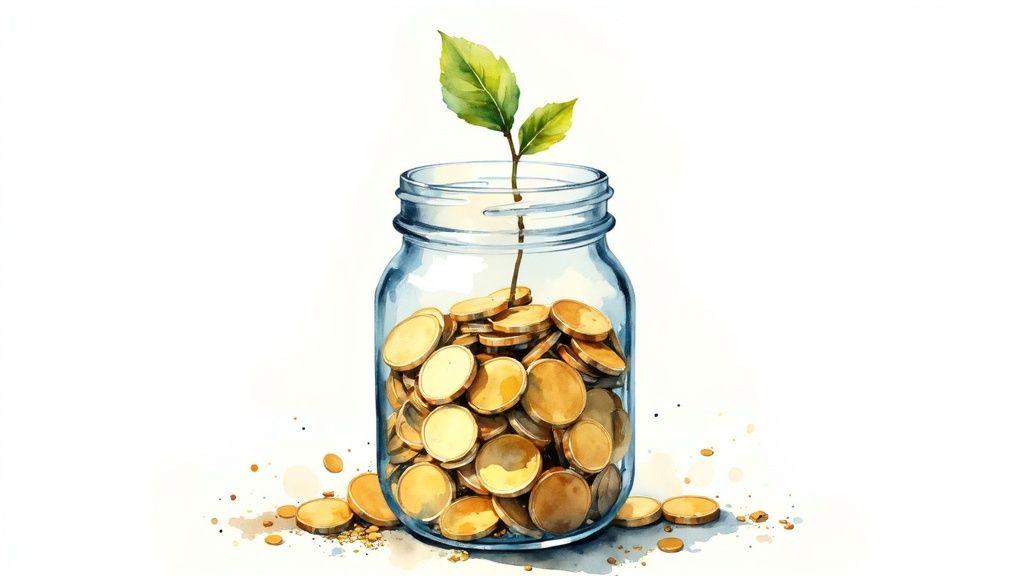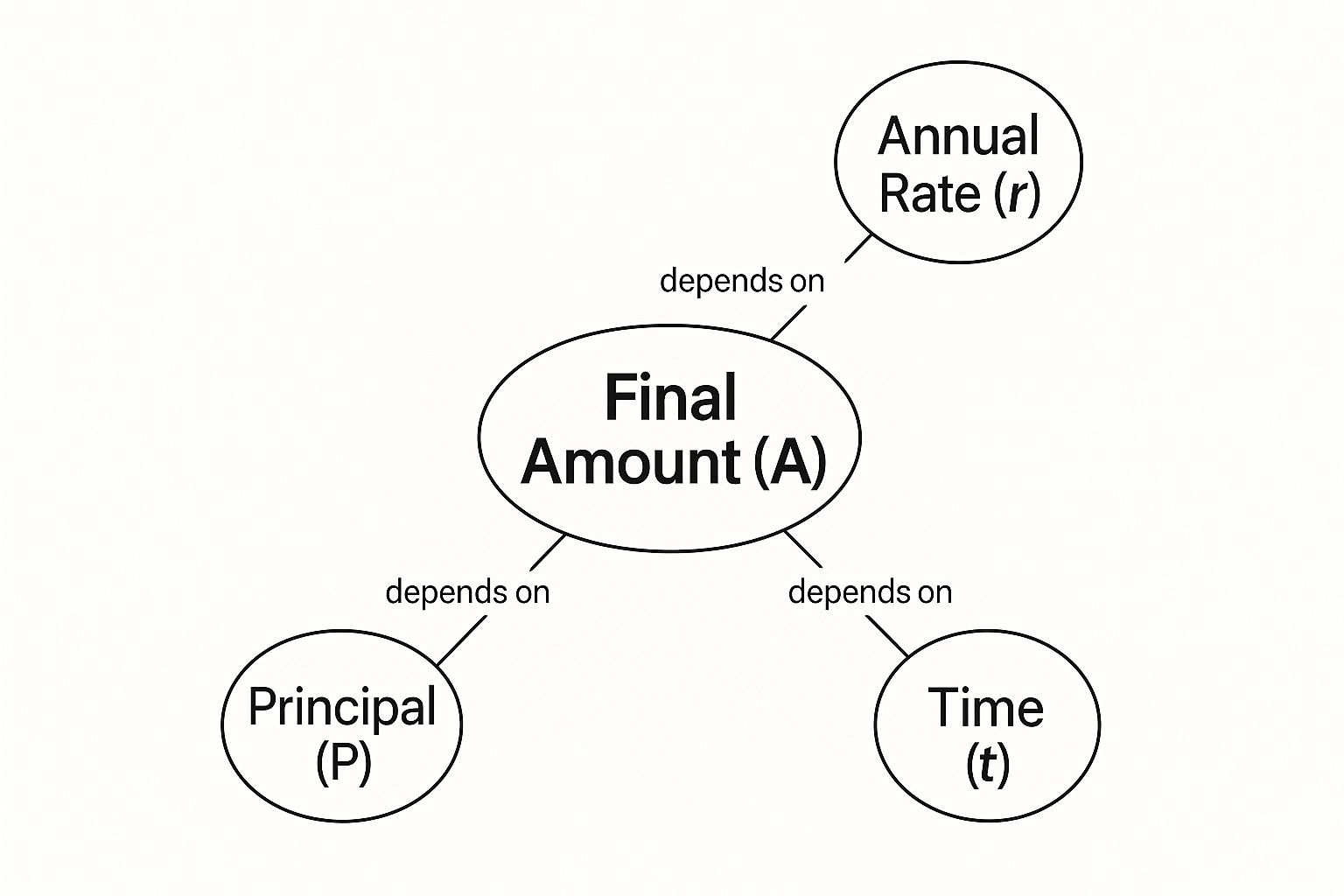At the heart of how money grows is a surprisingly simple bit of math. The formula for compound interest is A = P(1 + r/n)^(nt). This little equation is the engine that turns small, consistent savings into a significant nest egg by letting you earn interest on your interest.
Your Quick Guide to the Compound Interest Formula

Think of this formula as a recipe. Each letter represents a key ingredient, and changing any one of them can totally alter the final result. While we all get the basic idea of earning "interest on interest," this formula is what makes it a precise and predictable financial tool.
It’s the bedrock of modern personal finance, but it didn't just appear out of thin air. Its origins go all the way back to the 15th and 17th centuries, with thinkers like Luca Pacioli and Richard Witt laying the groundwork. They gave us concepts like the "Rule of 72" and early books on financial math that eventually led to the powerful formula we rely on today.
To really see what it can do for you, we need to pop the hood and look at each part individually.
Breaking Down the Compound Interest Formula Variables
Here’s a quick reference guide to the "ingredients" inside the compound interest formula. Understanding what each letter does is the key to predicting how your money will grow.
| Variable | What It Represents | Example Value |
|---|---|---|
| A | Future Value. This is the total amount you'll have at the end of the term. It’s your original money plus all the interest it's earned along the way. | $10,511.62 |
| P | Principal. This is your starting cash. It's the initial lump sum you put into a CD, savings account, or other investment. | $10,000 |
| r | Annual Interest Rate. This is the percentage your money grows by each year. The key is to express it as a decimal in the formula, so a 5% rate becomes 0.05. | 0.05 |
| n | Compounding Frequency. This is how often the bank calculates your interest and adds it to the balance. Common options are annually (n=1), quarterly (n=4), or monthly (n=12). | 12 (for monthly) |
| t | Time in Years. This is simply the number of years you plan to let your money grow. It's often the most powerful factor in the entire equation. | 1 (for a 1-year CD) |
Getting comfortable with these five variables gives you real control. You can instantly see how a bigger deposit, a better rate, more frequent compounding, or a longer timeline will impact your bottom line.
Our complete compound interest formula explained guide goes much deeper into how these elements work together. But nailing down these definitions is the essential first step to making smarter decisions with your savings.
How Each Variable in the Formula Drives Growth
Knowing the compound interest formula is one thing. Understanding how each part actually works is where the real power lies. Think of it less like a dry math problem and more like a control panel for growing your money—each variable is a lever you can pull.
Your Principal (P) is simply your starting pot of money. It’s the seed you plant. A bigger seed obviously has more potential from day one. Starting with a larger principal gives your investment an immediate head start, as every bit of interest earned is based on a larger initial number.
The True Drivers of Growth: Rate and Time
While the principal sets your foundation, the real action comes from the other variables. The annual interest rate (r) is the fuel. A higher rate is like higher-octane fuel; it just makes everything grow faster. This is precisely why it’s so critical to shop around and compare the APY on different savings accounts or CDs.
But the secret ingredient is the compounding frequency (n). This number dictates how often the bank calculates your earned interest and adds it back into your principal balance. The more frequently this happens, the sooner you start earning interest on your interest.
This visual shows how all the pieces—principal, rate, and time—flow together to determine your final amount.

As you can see, the final amount (A) is a direct result of how your initial investment (P), growth rate (r), and the duration (t) all interact.
Let's look at a quick example. Say you invest $10,000 at a 5% annual rate. The compounding schedule changes the outcome:
- Compounded Annually (n=1): After one year, you'd have $10,500.
- Compounded Monthly (n=12): You'd have a bit more, about $10,511.62.
- Compounded Daily (n=365): Your total creeps up to about $10,512.67.
The difference might look like pocket change at first, but over many years, those small gains really add up.
The most powerful variable you control is time (t). It's the silent multiplier that lets the compounding effect snowball, turning small, steady amounts into serious wealth.
Your Most Powerful Ally: Time
Ultimately, time (t) is the single greatest asset you have in this entire equation. The longer your money stays invested, the more times it gets to go through a compounding cycle. Each cycle builds on the last, creating that classic "hockey stick" growth curve that makes compound interest so famous.
This is the exact mathematical formula that powers these calculations.

Notice how time (t) and compounding frequency (n) are used as exponents. That position gives them an outsized impact on your final balance over the long haul. By truly understanding how these forces work together, you can make much smarter decisions to maximize your savings.
Applying the Formula to Your Own Investments

Okay, now for the fun part. Knowing the formula is one thing, but seeing it work with real money is what makes the lightbulb go on. Let's put the formula for compound interest to the test and see how it handles a few everyday investment scenarios.
This is where the math stops being abstract and starts becoming a powerful tool for planning your financial future. We’ll walk through three common examples: a standard savings account, a Certificate of Deposit (CD), and a long-haul retirement investment.
Scenario 1: A Standard Savings Account
Let's start simple. Imagine you open a high-yield savings account and deposit $5,000. The bank offers a 3% annual interest rate, and it compounds your interest monthly. You plan to just let it sit there for 5 years.
Here are our variables:
- Principal (P) = $5,000
- Rate (r) = 0.03 (remember to convert the percentage)
- Compounding (n) = 12 (for monthly)
- Time (t) = 5 years
When we plug these into the formula, A = 5000(1 + 0.03/12)^(12*5), we get a final balance of about $5,808.08. Not bad. That’s $808.08 in pure interest earned just for letting your money sit.
Scenario 2: A Certificate of Deposit (CD)
Now let's kick it up a notch with a Certificate of Deposit. CDs usually offer better rates than savings accounts because you agree to lock your money up for a specific term. This example shows what a difference a higher rate and more frequent compounding can make.
You can learn more about the specifics in our guide on how to calculate CD interest.
For this example, say you lock $10,000 into a 2-year CD that pays a 4.5% APY, compounded daily.
- Principal (P) = $10,000
- Rate (r) = 0.045
- Compounding (n) = 365 (for daily)
- Time (t) = 2 years
The calculation here is A = 10000(1 + 0.045/365)^(365*2), which comes out to $10,941.64. The daily compounding and better rate squeezed out $941.64 in interest in just two years.
The real power of the formula becomes undeniable when applied over decades. Time is the ultimate catalyst for growth, turning modest investments into significant wealth.
Scenario 3: A Long-Term Retirement Investment
This is where things get truly exciting. When you stretch the timeline out over decades, the results can be jaw-dropping. This is why financial advisors are always talking about starting early. It’s also why choosing the right long-term investments, like some of the best stocks for retirement, is so critical.
Let’s imagine a 30-year-old invests $15,000 into a diversified portfolio. We'll assume it earns an average annual return of 7%, compounded once per year. The plan is to leave it completely alone for 35 years, until they turn 65.
- P = $15,000
- r = 0.07
- n = 1 (annually)
- t = 35 years
Ready for this? The formula, A = 15000(1 + 0.07/1)^(1*35), gives us a final balance of $160,183.98. That initial $15,000 generated over $145,000 in growth all by itself. That is the magic of long-term compounding.
Visualizing the Power of Long-Term Compounding

The real magic of the formula for compound interest isn't something you see in a few months or even a year or two. Its true power is only unleashed over decades, turning a simple savings tool into a serious engine for building wealth. This is the classic "snowball effect"—patient, long-term investing lets your money grow exponentially.
Think about it like this. When you first start, your interest earnings are pretty modest because they’re based only on your initial deposit. But as that interest gets added back to your balance, the base for the next calculation grows. That next interest payment is slightly bigger. This cycle repeats over and over, with each period's growth becoming more meaningful than the last.
This isn't just theory; it's a proven reality. The S&P 500, for instance, has delivered an average annual return of about 10.61% since 1928. Thanks to compounding, a single dollar invested back then would have snowballed into over $1.5 million by 2004. It's a stunning real-world example of how reinvested growth creates incredible momentum over a lifetime.
The Two Investors Story
To really see how time impacts the final numbers, let's look at the classic story of two investors, Anna and Ben. Both are smart and understand the formula, but they start investing at different times.
- Anna, The Early Bird: She invests $5,000 at age 25. She doesn't add another dime, just letting it grow at a 7% average annual return.
- Ben, The Late Starter: He waits until age 35. To try and make up for lost time, he invests $10,000—double Anna's amount—at the same 7% return.
By the time they both turn 65, the outcome is eye-opening.
Despite investing half as much, Anna's early start allows her investment to grow to approximately $75,000. Ben, who started a decade later with twice the cash, ends up with only about $54,000.
This simple story proves a critical point: when you start investing is often more important than how much you start with. That extra decade gave Anna’s money far more time to compound, creating a cycle of growth that Ben couldn't catch up to, even with a much larger initial investment.
Understanding how often your interest is calculated is also a key piece of this puzzle. You can dig into the specifics of compound interest daily vs monthly to see how even small differences in frequency can amplify your results over the long run. Embracing this long-term view is what shifts your mindset from just saving money to truly building wealth.
Why Market Performance Changes the Outcome
The formula for compound interest is a beautiful piece of math—a reliable blueprint for growth. But like any blueprint, its real-world results depend entirely on the materials you give it. In this case, the most crucial material is the annual rate of return, or ‘r’.
This isn't a fixed, predictable number you can just set and forget. It’s a living, breathing figure that moves with the economic environment your money is in.
Think of it this way: your initial investment (the principal) is like a seed. The compound interest formula is the genetic code inside that seed, dictating how it can grow. But whether that seed flourishes or withers depends entirely on the soil it's planted in. Fertile, well-watered soil (a strong market) will produce a massive harvest. The same seed in dry, nutrient-poor soil (a weak market) will struggle. This is exactly how market performance shapes your investment returns.
The Global Rate of Return Lottery
The rate you plug into the formula is usually an average, but where that average comes from matters immensely. History shows just how wildly returns can vary from one country to the next.
For instance, data stretching back to 1900 reveals some stark differences:
- Australia delivered an impressive average real return of 6.4%.
- Denmark saw a remarkable 6.8%.
- In stark contrast, France and Portugal actually had negative real returns, around -0.1% and -0.2%, respectively, over similar long-term periods.
This drives home a critical point: a 6% return in a stable, growing economy is a world away from a 6% return in a volatile one. A country's economic strength, political stability, and industrial outlook directly feed into the ‘r’ your money can actually achieve.
Understanding the formula for compound interest is only half the battle. The other half is recognizing that the 'r' for rate is dictated by unpredictable market forces, making risk management essential.
While mastering the math is important, it's just as vital to have solid strategies for managing investment risk. An investor who ignores these bigger economic and geographic forces is only seeing part of the picture.
What This Means for Your Money
This variability isn’t meant to scare you—it’s meant to empower you to make smarter, more informed decisions. It’s not enough to just chase the highest advertised rate. You have to understand the context behind that rate.
A high-yield CD from a rock-solid, federally insured bank carries a completely different risk profile than a high-return stock in an unpredictable emerging market.
Ultimately, the compound interest formula is your map, but the economic market is the terrain you must cross. Acknowledging this reality is what separates basic math from truly strategic financial planning. It helps you account for the wild, unpredictable nature of global markets and position your money for genuine long-term success.
Answering Your Top Compound Interest Questions
Even after you've run the numbers, a few questions always pop up. The formula for compound interest is a fantastic tool, but applying it to your actual financial life means getting comfortable with the details.
Let's clear up some of the most common sticking points people have. Think of this as tying up the loose ends so you can build your savings strategy with total confidence.
What’s the Difference Between Simple and Compound Interest?
This is the big one, and it all comes down to how your earnings are tallied up.
Simple interest is paid only on your original deposit—that's it. If you put $1,000 into an account earning 5% simple interest, you get a flat $50 every single year. Predictable, but slow.
Compound interest, however, is calculated on your principal plus all the interest you've already earned. In that same $1,000 scenario, after year one, you'd start earning interest on $1,050, not the original $1,000. This is the famous "interest on your interest" effect that creates that incredible growth curve over time.
A good way to think about it: Simple interest is like getting a fixed paycheck for your money. Compound interest is like getting a small raise with every paycheck, so the next one is always bigger than the last.
How Can I Squeeze the Most Out of This Formula?
To get the best results from the compound interest formula, you need to focus on the parts of the equation you can actually influence. Pushing your returns higher really boils down to four key actions:
- Start with a bigger Principal (P): The more you start with, the larger the engine for your growth. A bigger base generates more interest right from day one.
- Find a higher Interest Rate (r): Don't underestimate small differences. An interest rate of 5% versus 4.5% might not sound like much, but it can easily translate into thousands of extra dollars over a decade or two.
- Choose more frequent Compounding (n): Whenever you have the choice, pick an account that compounds daily or monthly over one that only compounds annually. More frequent compounding puts your interest to work earning its own interest much faster.
- Give it more Time (t): This is your single most powerful ally. The longer your money sits and grows, the more dramatic and visible the effects of compounding become. Time does the heaviest lifting.
Does the Compound Interest Formula Account for Taxes or Fees?
This is a fantastic, real-world question. The standard formula, A = P(1 + r/n)^(nt), calculates your gross return—the total amount before anyone takes a cut. It’s a perfect-world scenario.
In reality, your net return, or what you actually walk away with, will be lower. You always have to plan for the costs that chip away at your earnings:
- Taxes: For most savings accounts and CDs, the interest you earn is taxable income.
- Fees: Some investment accounts or mutual funds have annual management fees that are deducted directly from your balance.
Always remember to factor these costs into your plans. The formula shows you the potential, but taxes and fees are a guaranteed part of the journey.
Ready to put these ideas into practice? The BankDepositGuide Certificate-of-Deposit Calculator lets you instantly see how your own savings could grow. Plug in your numbers, compare different CD rates and terms, and find the perfect fit to maximize your earnings.